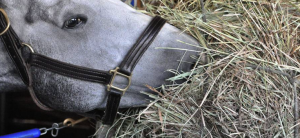These questions were addressed in a study designed by a group of researchers at California State University.
For the study, eight mature mares went through a two-week adaptation period during which they were housed in individual pens that were partially covered by a roof. Each horse received a flake of alfalfa (lucerne) hay and a flake of wheat hay in the morning. In the evening, each horse received a flake of teff hay and a flake of oat hay. After the adaptation period, the horses were paired in four groups. Horses in each group were fed one type of hay for a week, beginning with an amount equal to 2.2% of the horse’s body weight. More hay was given if a horse consumed all its hay during the feeding period. Unconsumed hay was removed and weighed, and voluntary consumption was calculated. The different types of hay were analyzed for nutrient composition.
Alfalfa hay was consumed in the greatest quantity by all horses. Wheat and teff hay were eaten at a lower rate than alfalfa, and oat hay was eaten in the smallest quantity. Chemical composition, and therefore nutrient value, was not a good predictor of voluntary intake. Wheat and oat hay had the same chemical composition but horses ate more wheat hay, possibly because the wheat hay contained more grain.
Overall, hay consumption increased through each week of the study, but alfalfa was the only hay for which consumption met the horses’ requirement for energy. Alfalfa and teff hay were eaten in large enough quantities to meet the requirements for protein, lysine, calcium, and phosphorus, but the consumed amounts of oat and wheat hay did not meet these requirements.
Hay of any type will have a range of quality and palatability based on stage of maturity when cut, soil type, rainfall, and curing conditions. Just as each type of hay has a different nutritional profile, horses vary slightly in their requirement for energy and nutrients. Horse owners should buy clean, fresh hay with no signs of mold; store it indoors with good ventilation to prevent deterioration; provide hay to stabled horses several times a day; monitor horses for weight loss or gain; and feed grain products to meet energy demands that are not supplied by an all-forage diet.
If horses refuse to eat hay when it is offered, the hay may be slightly moldy or of poor quality, or the horse may have health issues (sore mouth, gastric ulcers, low-grade colic) that can be diagnosed and treated by a veterinarian.
Article brought to you by KER.

 Equine diets should be based on forage (grass or hay) and therefore consumption of hay is important for stalled horses or those without access to fresh pasture. What kind of hay do horses prefer? Are preferences based on taste, texture, nutritional content, or other factors? Are there some types of hay that horses are reluctant to eat?
Equine diets should be based on forage (grass or hay) and therefore consumption of hay is important for stalled horses or those without access to fresh pasture. What kind of hay do horses prefer? Are preferences based on taste, texture, nutritional content, or other factors? Are there some types of hay that horses are reluctant to eat?